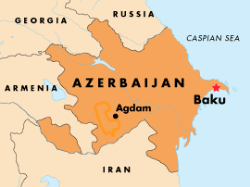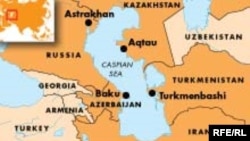The EU was expected to be the Stability Pact's chief sponsor. But now the project -- first floated by regional leaders at the 1999 Istanbul summit of the Organization for Security and Cooperation in Europe (OSCE) -- now appears defunct.
Robert Liddell, a senior official with the EU's executive European Commission, told today's hearing -- held by the Political Affairs Committee of the Parliamentary Assembly of the Council of Europe -- he does not consider the project an improvement on the EU's existing policy.
"I don't see much difference between what people are talking about in the Stability Pact and what the ENP is offering," he said. "If you then build in other aspects of the European Union policy, of [its] security strategy, and other aspects of the [EU] Common Foreign and Security Policy -- those may not be part of the ENP, exactly but they are flanking policies that lead to a total package from the European Union."
Liddell said the ENP already embodies a statement of the EU's desire for stability, good governance and economic reforms in the South Caucasus.
Not The Balkans
Speaking on behalf the EU member states, the newly appointed special representative for the South Caucasus, Peter Semneby, discouraged parallels between the proposed pact and the successful, EU-backed Stability Pact for Southeastern Europe.
Semneby said most progress made in the Balkan countries would not have been possible without the "overwhelming incentive" of EU membership -- something the South Caucasus countries don't have.
"[An] EU membership perspective is not present in the Southern Caucasus, unlike the Balkans," he said. "It is indeed the European membership perspective that has played the most important role in the Balkans in terms of reforms that have been undertaken."
Semneby also noted that the South Caucasus is a far more unstable region, with its lingering "frozen conflicts" and Russia's continued influence.
Caspian Energy Link
Both Semneby and Liddell indicated the EU also prefers to see the South Caucasus in a wider context. This is partly due to the active interest taken in the region by key countries such as the United States, Russia, Turkey, and Iran. But the EU's evolving quest for energy security also plays an important role.
Liddell said the EU views the Black Sea region as integrally linked to the Caspian Sea and energy reserves in Central Asia.
The representatives of Georgia, Armenia, and Azerbaijan present at today's hearing appeared lukewarm at best in their support for the idea of a Stability Pact.
Georgia's ambassador to the EU, Salome Samadashvili, said her country is keen to follow its own path toward integration with the EU and NATO, unencumbered by regional commitments.
"We [Georgia] do see ourselves as the crucial link between the -- if you wish -- the more stable Black Sea region, and the Southern Caucasus, and we are ready to do what we can in order to strengthen stability in the region, strengthen regional cooperation," she said. "However, as the Georgian government has mentioned many times, we will not be captive to any regional approach, and Georgian society will move forward steadily on the course which it has chosen [pursuing closer links with the EU and NATO]."
Nagorno-Karabakh Prevents Progress
Armenia and Azerbaijan spoke in favor of a more regionally oriented view. However, both made cooperation conditional on progress in the conflict over Nagorno-Karabakh.
Varuzhan Nessissian, head of the Armenian Foreign Ministry's department for the OSCE, said his country sees mainly economic benefits in a possible Stability Pact. But, he said, Armenia's support to the project remains "qualified," and will depend on its acceptance by other countries, as well as a promise of eventual EU membership.
"We do believe in Armenia that such an arrangement is possible and workable if at least two preconditions are met," he said. "First, there must be strong political will on the part of the countries in the region to enter into a long-term stability arrangement, notwithstanding existing problems between some of them. Second, as in the case of [the] Stability Pact for the Balkans, there should be some concrete and eventual European [membership] prospect in a reasonable time frame. With these two in place, the Stability Pact for the South Caucasus has a chance to happen."
Azerbaijan's ambassador to the EU, Arif Mammadarov, said Armenia's withdrawal from Azerbaijani territory is key to any prospects of regional cooperation.
"Without [the] fundamental principle of respect for each other within our identified territories -- which are internationally recognized territories -- without this principle, without recognizing each other's houses, to be good neighbors is impossible," he said. "The first principle is the recognition of the internationally recognized borders of each other."
Although the EU appears to have dashed hopes for a South Caucasus Stability Pact, its involvement in the region will grow significantly with the impending signature of ENP action plans with Georgia, Armenia, and Azerbaijan. The EU is also likely to significantly increase its funding for the three countries from 2007 onwards.
The Nagorno-Karabakh Conflict
 Click on the image to view an enlarged map of the Nagorno-Karabakh conflict zone
Click on the image to view an enlarged map of the Nagorno-Karabakh conflict zone
In February 1988, the local assembly in Stepanakert, the local capital of the Azerbaijani region of NAGORNO-KARABAKH, passed a resolution calling for unification of the predominantly ethnic-Armenian region with Armenia. There were reports of violence against local Azeris, followed by attacks against Armenians in the Azerbaijani city of Sumgait. In 1991-92, Azerbaijani forces launched an offensive against separatist forces in Nagorno-Karabakh, but the Armenians counterattacked and by 1993-94 had seized almost all of the region, as well as vast areas around it. About 600,000 Azeris were displaced and as many as 25,000 people were killed before a Russian-brokered cease-fire was imposed in May 1994.
CHRONOLOGY: For an annotated timeline of the fighting around Nagorno-Karabakh in 1988-94 and the long search for a permanent settlement to the conflict, click here.
 Click on the icon to view images of the Nagorno-Karabakh conflict (Flash required)
Click on the icon to view images of the Nagorno-Karabakh conflict (Flash required)
To view an archive of all of RFE/RL's coverage of Nagorno-Karabakh, click here.


















